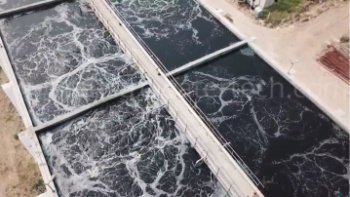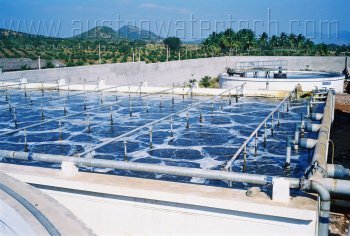- You are here: >>
- Home >>
- Our Services >>
- Aeration System >>
AERATION SYSTEM
 Aeration is the process of increasing the oxygen saturation of the water, as a result which produces active sludge that can be used as fertilizers. Aeration is used in water treatment as a pretreatment in the process of removing iron and hydrogen sulfide (rotten egg smell) from water. Air is a powerful oxidizer of both iron and hydrogen sulfide. It quickly converts unfilterable ferrous iron to filterable ferric iron, and it reduces hydrogen sulfide to elemental sulfur, which is easily removed from water by a filter. Aeration removes odour and tastes due to volatile gases like hydrogen sulphide and due to algae and related organisms. Aeration also oxidize iron and manganese, increases dissolved oxygen content in water, removes CO2 and reduces corrosion and removes methane and other flammable gases. Principle of treatment underlines on the fact that volatile gases in water escape into atmosphere from the air-water interface and atmospheric oxygen takes their place in water, provided the water body can expose itself over a vast surface to the atmosphere. This process continues until an equilibrium is reached depending on the partial pressure of each specific gas in the atmosphere.
Aeration is the process of increasing the oxygen saturation of the water, as a result which produces active sludge that can be used as fertilizers. Aeration is used in water treatment as a pretreatment in the process of removing iron and hydrogen sulfide (rotten egg smell) from water. Air is a powerful oxidizer of both iron and hydrogen sulfide. It quickly converts unfilterable ferrous iron to filterable ferric iron, and it reduces hydrogen sulfide to elemental sulfur, which is easily removed from water by a filter. Aeration removes odour and tastes due to volatile gases like hydrogen sulphide and due to algae and related organisms. Aeration also oxidize iron and manganese, increases dissolved oxygen content in water, removes CO2 and reduces corrosion and removes methane and other flammable gases. Principle of treatment underlines on the fact that volatile gases in water escape into atmosphere from the air-water interface and atmospheric oxygen takes their place in water, provided the water body can expose itself over a vast surface to the atmosphere. This process continues until an equilibrium is reached depending on the partial pressure of each specific gas in the atmosphere.
How does Aeration System Work?
Aeration provides oxygen to bacteria for treating and stabilizing the wastewater. Oxygen is needed by the bacteria to allow bio degradation to occur. The supplied oxygen is utilized by bacteria in the wastewater to break down the organic matter containing carbon to form carbon dioxide and water. Without the presence of sufficient oxygen, bacteria are not able to biodegrade the incoming organic matter in a reasonable time. In the absence of dissolved oxygen, degradation must occur under septic conditions which are slow, odorous, and yield incomplete conversions of pollutants. Under septic conditions, some of the biological process convert hydrogen and sulfur to form hydrogen sulfide and transform carbon into methane. Other carbon will be converted to organic acids that create low pH conditions in the basin and make the water more difficult to treat and promote odor formation. Bio degradation of organic matter in the absence of oxygen is a very slow biological process.
Aeration System Maintenance
Regardless of the quality of the equipment purchased, it will not perform satisfactorily unless maintained in accordance with the manufacturer’s recommendations for maintenance, cleaning, and part replacement. Keep a logbook to record equipment maintenance and repairs. Proper, adequate ventilation is a must when operating an aeration system. Tank needs occasional cleaning of precipitated sulfur, iron sulfide, rust, and algae. A valve controlled drain line to the ground surface makes flushing the storage tank, once or twice each year, easier.

Aerators
TYPES OF AERATORS:
Aerators fall into two categories. They either introduce air to water, or water to air. The water-in air method is designed to produce small drops of water that fall through the air. The air-in-water method creates small bubbles of air that are injected into the water stream. All aerators are designed to create a greater amount of contact between air and water to enhance the transfer of gases and increase oxidation.
Cascade Aeration Systems:
A cascade aerator (one of the oldest and most common aerators) consists of a series of steps that the water flows over (similar to a flowing stream). In all cascade aerators, aeration is accomplished in the splash zones. Splash zones are created by placing blocks across the incline. (They are the oldest and most common type of aerators.) Cascade aerators can be used to oxidize iron and to partially reduce dissolved gases.
Cone Aerators:
Cone aerators are used primarily to oxidize iron and manganese from the ferrous state to the ferric state prior to filtration. The design of the aerator is similar to the cascade type, with the water being pumped to the top of the cones and then being allowed to cascade down through the aerator.
Slat and Coke Aerators:
Slat and coke trays are similar to the cascade and cone aerators. They usually consist of three-to-five stacked trays, which have spaced wooden slats in them. The trays are then filled with fist sized pieces of coke, rock, ceramic balls, limestone, or other materials. The primary purpose of the materials is providing additional surface contact area between the air and water.
Draft Aerators:
Draft aerators are similar to other water-into-air aerators, except that the air is induced by a blower. There are two basic type of draft aerators. One has external blowers mounted at the bottom of the tower to induce air from the bottom of the tower. Water is pumped to the top and allowed to cascade down through the rising air. The other, an induced-draft aerator, has a top-mounted blower forcing air from bottom vents up through the unit to the top. Both types are effective in oxidizing iron and manganese before filtration.
Spray Aerators:
Spray aerators have one or more spray nozzles connected to a pipe manifold. Water moves through the pipe under pressure, and leaves each nozzle in a fine spray and falls through the surrounding air, creating a fountain affect. Spray aeration is successful in oxidizing iron and manganese and increases the dissolved oxygen in the water.
Pressure Aerators:
There are two basic types of pressure aerators. One uses a pressure vessel; where water to be treated is sprayed into high-pressure air, allowing the water to quickly pick up dissolved oxygen. The other is a pressure aerator commonly used in pressure filtration. Air is injected into the raw water piping and allowed to stream into the water as a fine bubble, causing the iron to be readily oxidized. The higher the pressure, the more readily the transfer of the oxygen to the water. The more oxygen that is available, the more readily the oxidation of the iron or manganese.
Centrifugal Aerators:
Centrifugal aerators create enhanced conditions for dissolving gas into liquid phase, including bubble size, and bubble size distribution and duration of interaction with liquid. Centrifugal aerators combine several elements:
1. High turbulence swirling flow of liquid;
2. Orthogonal flow of liquid and gas;
3. Constant pressure inside the vessel;
4. Optimum flow velocity generating centrifugal forces thereby extending diffusion rate within the vessel;
5. Very small pores, through which gas permeates into the liquid and is sheered off into liquid phase, thereby forming small bubbles.
Three basic control tests are required for aeration:
- Dissolved oxygen – The concentration of dissolved oxygen can be used to determine if the water is over or under-aerated. The pH test will give an indication of the amount of carbon dioxide removed.
- pH – pH increases as carbon dioxide is removed. pH can also be used to monitor the effective range for hydrogen sulfide, iron, and manganese removal.
- Temperature – The saturation point of oxygen increases as the temperature decreases. As water temperature drops, the operator must adjust the aeration process to maintain the correct dissolved oxygen level.
Why do you Need Aeration System?
Aeration provides oxygen to bacteria for treating and stabilizing the water.Any procedure by which oxygen is added to water can be considered a type of water aeration. A well designed aeration system has a direct on impact on water treatment systems. This being the only criterion, there are a variety of ways to aerate water. These fall into two broad areas – surface aeration and subsurface aeration.
Austro water tech designs every piece of aeration equipment with the customer’s need, with an aim in improving water and wastewater quality and minimizing operational expenses. Clients use our aerators worldwide in a range of municipal and industrial wastewater treatment facilities. We tailor each of our products for a particular range of applications and design them as durable, providing trouble-free operation for the life of the equipment.
As a proven technology, subsurface aeration is one of the foundation for improving and maintaining proper water quality and clarity in ponds and lakes. Subsurface aeration eliminates stratification, increases dissolved oxygen levels and improves water quality. It also creates the proper conditions to grow and maintain large populations of beneficial microbes. Aeration treatments are employed for controlling algae along with odor control in order to reduce the cost associated with conventional chemical treatments.
How Can We Help With Your Aeration Needs?
We engineer all Austro’s aeration equipment to match your unique water treatment or wastewater treatment challenges. Our aerators are ruggedly built, designed to provide customers with extended, trouble-free operation.Contact Austro Water Tech to let our technical experts help you determine the proper sizing, layout, and operation of your next aeration or mixing system.Austro’s aerators, mixers, and diffusers are engineered to match your operation’s unique water or wastewater treatment challenges.





No Comments
Sorry, the comment form is closed at this time.